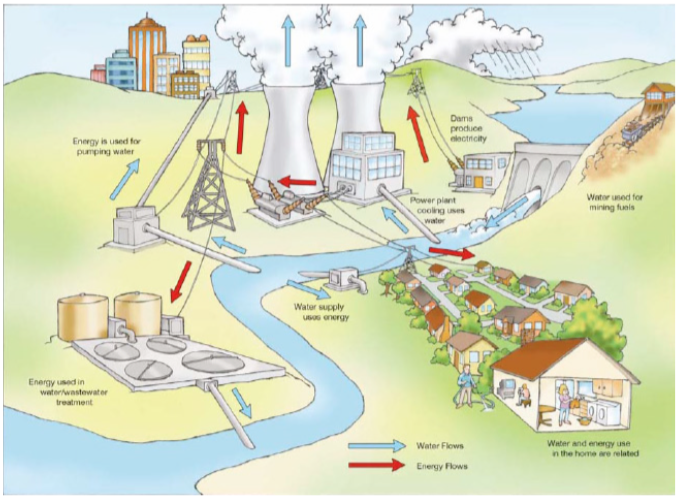废水处理厂(WWTP)发电:能源治理到能源生产
Time of Policy Implementation
New and renewable energy production from WWTPs’ of Seoul had been planned and carried out since 2007 based on the treatment conditions and characteristics of each WWTP.
When the new and comprehensive energy policy of Seoul, aka ‘One Less Nuclear Power Plant’ was launched in 2012, the projects on the energy production in WWTP were incorporated into the new energy policy of Seoul, and carried out more actively using the resources and conditions of the WWTPs.
When the new and comprehensive energy policy of Seoul, aka ‘One Less Nuclear Power Plant’ was launched in 2012, the projects on the energy production in WWTP were incorporated into the new energy policy of Seoul, and carried out more actively using the resources and conditions of the WWTPs.
Project ‘One Less Nuclear Power Plant’
The city of Seoul announced that the city will implement the project of ‘One Less Nuclear Power Plant’ as one of the local energy policies in April 2012. The main purpose of the ‘One Less Nuclear Power Plant’ project was that the city would have effective and preemptive measurements to mitigate and adopt the impact of climate change and energy crisis such as Fukushima nuclear disaster on March 11, 2011 and national blackout on September 15, 2011 (Yu et al., 2015). Conserving energy and producing new and renewable energy, the city of Seoul can save the energy of 2 million TOE, which is the same amount of energy for a nuclear power plant generate. The goal was achieved 6 month before the end of the project, in June 2014 (Yu et al., 2015).
2nd Phase of ‘One Less Nuclear Power Plant’ Project
The city of Seoul started the 2nd phase of ‘One Less Nuclear Power Plant’ project after successful completion of the 1st phase of the project in 2014. The goal of the 2nd phase of the project is to realize the value of the project by changing the related institutions and structures of energy production and consumption for eco-friendly energy projects. The essential goal of the 2nd phase project of ‘One Less Nuclear Power Plant’ is energy self-sufficiency of 20% (Figure 1). The energy self-sufficiency which was 4.2% in 2013 will be increased up to 20% in 2020 by 1) new and renewable energy and combined heat and power generation (46%), and improvement of energy efficiency and conservation (54%).
It is required for the city of Seoul to have a fundamental base of self-sufficient energy supply to make a city of ‘no-blackout’ to be prepared for energy crisis such as the national blackout occurred on September 15, 2011.
The three important approaches are conservation of energy including fossil fuel, distributed production of new and renewable energy, and efficient use of energy.
It is required for the city of Seoul to have a fundamental base of self-sufficient energy supply to make a city of ‘no-blackout’ to be prepared for energy crisis such as the national blackout occurred on September 15, 2011.
The three important approaches are conservation of energy including fossil fuel, distributed production of new and renewable energy, and efficient use of energy.
Figure 1. Energy self-sufficiency goal of Seoul (Lee, 2015)

Seoul made a plan to increase energy self-sufficiency of the city. The plan has strategies to change Seoul from energy consuming city to energy producing city. The strategy includes project to transform the structure of the energy producing and supplying system of Seoul, i.e., from large scale centralized system to distributed system. With decreasing power demand of 9,553 GWh, producing new and renewable energy of 2,711 GWh, and producing thermal power generation and combined heat and power generation of 5,444 GWh, the city of Seoul will save and produce energy of total 8,155 GWh by 2020 to achieve the goal of energy self-sufficiency of 20% (Figure 2).
Figure 2. Energy saving and producing in Seoul through the 2nd phase project of ‘One Less Nuclear Power Plant’ (Lee, 2015)
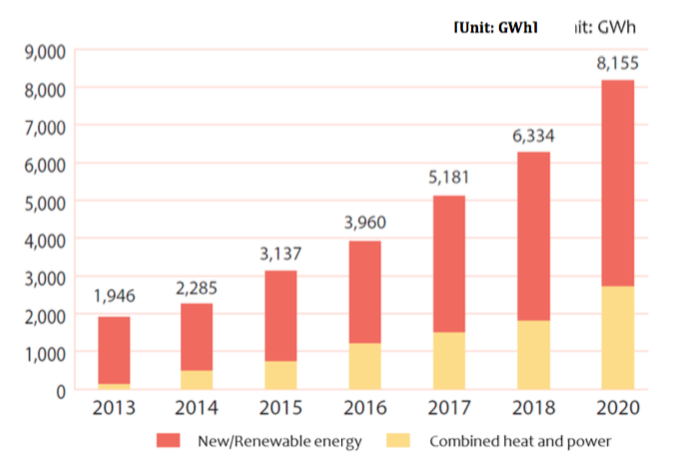
The WWTPs can contribute much to successful results of the project by producing new and renewable energy such as biogas, small hydropower plant, geothermal, and photovoltaic power generating facilities.
Situational Background for Policy Implementation
Sewerage System of Seoul
In the Chosun dynasty (1392 – 1897), wastewater from individual house was collected naturally in the lower land area and on the road, and discharged to streams or infiltrated into underground via ditches. Only the Chung Gye Chun (or Chung Gye stream), the largest stream in Seoul except for the Han river, was dredged and managed periodically (Figure 3). According to history, there was massive dredging and repairing in Chung Gye Chun and Ok Chun to be prepared for flood from the streams in 1412 (Bureau of Water Management, 2009a). There was a record on structures used for basic sewerage system in the Shilla dynasty (57 BC – 935 AD). Modern sewerage system was constructed and operated after 1921. 225 km of sewer lines including the main and the branch sewer were constructed, improved, and maintained until 1943.
The purposes of the sewer system construction and operation at that time were, prevention of urban flood, accumulation of and contamination by wastewater, and treatment of human waste discharged from houses.
Storm water drainage had been added as one of the main functions of the sewer system.
The disposal of human waste was changed from being taken away by hands to being flushed with water due to improvement in life standard and rapid economic growth with urbanization and industrialization. Construction and maintenance of WWTP and sewer system got more interests as the contaminants loads were increased and more of the streams were polluted
Figure 3. Old Chung Gye Chun
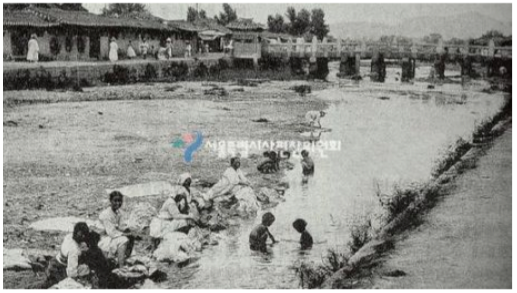
Ending the Korean War in 1953, massive construction and maintenance of sewer systems had been carried out in order to rehabilitate the city of Seoul since 1954 with various financial aides from international organizations. Huge amount of budget was invested and the 1st phase of the project to cover the top of the Chung Gye Chun in 1959.
An administrative organization to manage the sewerage system of Seoul, Department of Sewerage, Bureau of Water and Wastewater, on March 17, 1959. Laws on sewerage system were enacted in 1966, which is an institutional system for sewerage management.
The city of Seoul made a plan to construct the 1st WWTP in Seoul, Chung Gye Chun WWTP in 1965. The project was carried out with the loan of 350,000 US dollars from AID and the construction of the Chung Gye Chun WWTP with the treatment capacity of 150,000 m3/day was completed in 1976.
Sewerage service was late to drinking water service. The sewerage service rate was 27.9% in 1970 while that of drinking water service was 85.6%. Most of wastewater and storm water flew through the top of the road not the sewer lines. The sanitation condition in Seoul at that time was very poor. Not many people could think that WWTP was essential to improve the sanitation conditions for the citizens. The poor people gathered to Seoul after the Korean War lived in a shantytown along the Chung Gye Chun. The Chung Gye Chun or the Chung Gye stream itself functioned as a WWTP. The other small streams in Seoul were in the same conditions as the Chung Gye Chun. The sewerage service rate exceeded 50% after 1977 and the sewerage system had been expanded rapidly through 1980’s. The rate increased from 68.8% in 1982 to 85.9% in 1983, after only one year. The rate exceeded 90% in the mid 1980’s and got to 100% in 1997 (Seoul Development Institute, 2010).
Seoul held the Asian Games in 1986 and the Olympic Games in 1988 consecutively. The city had to improve all of the urban environments and WWTPs and sewerage system were constructed massively and actively. Due to the efforts of the city, the service rate of Seoul reached 90% in the mid 1980’s. As the Joong Rang WWTP which was the Chung Gye Chun WWTP was expanded, and the Tan Chun WWTP, the Seo Nam WWTP, and the Na Ji WWTP were constructed in 1986, the service rate got to 100% in 1997 (Table 1).
The name of WWTP was renamed as ‘Water Reclamation Center’, which meant that the ‘Water Reclamation Center’ was not only a plant to treat wastewater but also a center to recycle wastewater and produce useful and necessary water resource (Figure 4).
Figure 4. The 4 WWTPs of Seoul (Bureau of Water Management, 2009b)

Table 1. WWTPs in Seoul
| Joong Rang | Nan Ji | Tan Chun (outsource to private) | Seo Nam (outsource to private) | Total | |
| Treatment Capacity |
159 | 86 | 90 | 163 | 498 |
| Service area | 10 boroughs | 7 boroughs, 1 city | 4 boroughs, 2 cities | 9 boroughs, 1 city | All the 25 boroughs of Seoul, 4 cities of Kyung Ki Province |
Energy Policy of Seoul
The total power consumption in Seoul in 2011 was 46,903 GWh, 10.9% of the total national consumption and energy self-sufficiency was only 2.8%. Due to the low electric power reserve rate, there was a massive black out in Korea including Seoul on September 15, 2011. As it was very possible to have another blackout in the future, it was necessary to improve energy (power) self-sufficiency to cope with power disaster (Yu et al., 2015). The city of Seoul has been carrying out the 2nd phase of the project ‘One Less Nuclear Power Plant’ (aka, Energy Producing City) to increase the energy self-sufficiency to 20% in 2020 after successful completion of the 1st phase of the project since August 2014.
The city made a plan to achieve the goal of the energy self-sufficiency of WWTP of 50% by 2030 through energy conservation and new and renewable energy production, according to the ‘Master plan for energy self-sufficiency’ of the Minister of Environment (January 2010). As of 2016, the energy self-sufficiency of WWTP of Seoul is 51%. The next goal of Seoul for the energy self-sufficiency of WWTP is 100% by 2020.
Sustainable Development Goals
UN has announced the new goal of ‘Sustainable Development Goals (SDGs)’ for the next 15 years from 2016 to 2030 after successful completion of the project of ‘Millennium Development Goals’. The projects for SDGs were launched on December 5, 2015 with selection of the post-2015 SDG agenda at the UN General Assembly.
Sustainable development can be defined in many ways, but according to IISD (International Institute for Sustainable Development), the most frequently quoted definition is from ‘Our Common Future’, also known as the Brundtland Report.
“Sustainable development is development that meets the needs of the present without compromising the ability of future generations to meet their own needs. It contains within it two key concepts: 1) the concept of needs, in particular the essential needs of the world's poor, to which overriding priority should be given; and 2) the idea of limitations imposed by the state of technology and social organization on the environment's ability to meet present and future needs. (http://www.iisd.org/topic/sustainable-development)” UN SDGs include 17 goals and 169 targets (Figure 5).

Figure 5. UN Sustainable Development Goals

Although all the UN member countries of 193 agreed to make every effort to achieve the SDGs, the main body of SDGs fulfillment has to be city. In this respect, the city of Seoul held ‘International Forum on Urban Policy for the Sustainable Development Goals’ on June 8, 2016, and announced that Seoul will lead the projects to achieve the SDGs.
One of the prerequisites for SDGs is sustainable production or efficient use and reuse of resources. The energy production from WWTP is an indispensable policy for Seoul to achieve the SDGs.
Water-Energy NEXUS
In all cases with water production and use including water treatment using source water from ground water or surface water, supply the customers with treated water, collecting and treating wastewater, discharging the treated effluent to stream, reuse the wastewater, and desalinating brine and sea water, energy is inevitable.
For instance, energy used for water systems in 2011 was 12.6% of total energy consumed (http://goo.gl/2pFxgQ). The energy used for wastewater treatment is about 0.1~0.3% of total energy used in the US (Stillwell et al., 2010). In Korea, the public sector uses 4.6% of total energy and 1.02% of the energy is used for drinking and wastewater systems (Choi, 2015). Drinking water system uses 0.8% of total energy used in Seoul while wastewater and sewerage system uses 0.9% (Choi, 2015).
Water is also required for energy production. Cooling water for thermal power generation, water for hydropower generation and mining, and water for fuel processing are the water resources used for energy production. The water used for cooling thermal power generation system takes 48.7% of the total water used for energy production in the US. This is 52% of freshwater withdrawal and 10% freshwater consumption (Figure 6).
Figure 6. Schematic illustration on Water-Energy NEXUS http://goo.gl/UCozax
The approaches recommended building a virtuous cycle of water-energy NEXU in wastewater treatment and sewerage system are as follows; 1) energy conservation, 2) efficient system, 3) Best Management Practice (BMP), and 4) new and renewable energy production (Choi, 2015).
According to the scenarios made by National Renewable Energy Laboratory of Department of Energy (DOE), 50% of water resource used for power generation can be saved if new and renewable energy use can be increased to 80% by 2050 (NREL, 2012).
UN reported that 9.2 billion people will live together on earth and energy consumption is expected to increase by 80% (Le Blanc, 2012). Although new and renewable energy take only 10% of total energy produced, the new and renewable energy produced from WWTP has a lot of meanings and significance as it is the only sustainable energy.
About 30% of energy can be saved in most of WWTPs through efficiency improvement and changes in treatment processes (Means, 2004). 3~6% of total energy used in a WWTP can be saved only with efficient operation of aeration process and pumps (Hoppock and Webber, 2008).
New and renewable energy production along with efficient operation of wastewater treatment plant is one of the critical factors for sustainable Water-Energy NEXUS.
Climate Change and Water-Energy NEXUS
In general, climate change reduces the availability of water resources and more energy has to be consumed to increase the availability. Increased energy demand and financial burden will magnify the Water-Energy Conflict. The conflict by the severe drought in 2015 could be moderated by cheaper oil price, did not rise to the surface. As the water-energy conflict can be escalated any time in the future with climate change, the policy for energy self-sufficiency of water system is always very important.
Importance of the Policy
There are about 20 communities in Germany to supply the 100% of energy for the comminity with new and renewable energy. Schleswig-Holstein has 15 communities and became the 1st state using 100% new and renewable energy. The communities with 100% new and renewable energy has limits of geographical characteristics (i.e., very windy mountainous area) and small population less than 10,000.
According to the ‘master plan for climate protection’ for Frankfurt reported by Fraunhofer Gesellschaft in June 2013, the city will reduce carbon emission by more than 95% by 2050 compared with that of 1990 and all the energy demand will be met with new and renewable energy (Shin, 2016).
It was urgent for Seoul to get prepared for accident like the massive blackout in 2011 through energy conservation and production capacity expansion for new and renewable energy, not only as the long-term and strategic plan to mitigate and adopt to climate change. It became the prior energy policy for Seoul to increase power self-sufficiency to operate the urban infrastructure in any case including the massive blackout (Yu, 2015). The WWTP is one of the best fitted urban infrastructures to increase system efficiency and produce new and renewable energy.
Improvement of system efficiency and energy production are the most important factors for the water processes to secure the virtuous cycle of Water-Energy NEXUS. In addition, as the wastewater flows into a WWTP has high concentration of organic materials which can be converted into various types of energy. In this respect, the identity of WWTP of Seoul has to be changed from ‘treatment’ of wastewater to ‘production’ of resources and energy.
Wastewater treatment and sewerage system are composed of the processes with concentrated investment and energy. Therefore, the tightened water quality standards for the effluent from WWTP will definitely be connected to expansion of treatment facilities which will increase financial burden of a local government. Energy self-sufficiency of WWTP will contribute to reducing the financial load of the local government by increasing system efficiency and energy production.
According to the ‘master plan for climate protection’ for Frankfurt reported by Fraunhofer Gesellschaft in June 2013, the city will reduce carbon emission by more than 95% by 2050 compared with that of 1990 and all the energy demand will be met with new and renewable energy (Shin, 2016).
It was urgent for Seoul to get prepared for accident like the massive blackout in 2011 through energy conservation and production capacity expansion for new and renewable energy, not only as the long-term and strategic plan to mitigate and adopt to climate change. It became the prior energy policy for Seoul to increase power self-sufficiency to operate the urban infrastructure in any case including the massive blackout (Yu, 2015). The WWTP is one of the best fitted urban infrastructures to increase system efficiency and produce new and renewable energy.
Improvement of system efficiency and energy production are the most important factors for the water processes to secure the virtuous cycle of Water-Energy NEXUS. In addition, as the wastewater flows into a WWTP has high concentration of organic materials which can be converted into various types of energy. In this respect, the identity of WWTP of Seoul has to be changed from ‘treatment’ of wastewater to ‘production’ of resources and energy.
Wastewater treatment and sewerage system are composed of the processes with concentrated investment and energy. Therefore, the tightened water quality standards for the effluent from WWTP will definitely be connected to expansion of treatment facilities which will increase financial burden of a local government. Energy self-sufficiency of WWTP will contribute to reducing the financial load of the local government by increasing system efficiency and energy production.
Relationship with Other Policies
Adoption of Paris Agreement
The Paris Agreement was adopted at the 21st Conference of Parties (COP21), Paris in December 2015. The agreement was about the new climate corresponding mechanism to replace the Kyoto protocol after 2020. The agreement had meanings and significance as it made all the countries, regardless of developed and developing countries, work together to mitigate and adopt the impact by climate change (Kim, 2016).
The Paris Agreement’s central aim is to strengthen the global response to the threat of climate change by keeping a global temperature rise this century well below 2 degrees Celsius above pre-industrial levels and to pursue efforts to limit the temperature increase even further to 1.5 degrees Celsius. Additionally, the agreement aims to strengthen the ability of countries to deal with the impacts of climate change. To reach these ambitious goals, appropriate financial flows, a new technology framework and an enhanced capacity building framework will be put in place, thus supporting action by developing countries and the most vulnerable countries, in line with their own national objectives. The Agreement also provides for enhanced transparency of action and support through a more robust transparency framework (UNFCCC, 2016).
In addition, the agreement requested each country to make and report strategies for long-term low greenhouse gas (GHG) emission development by 2020 (Kim, 2016). Korea proposed 37% reduction by 2030 BAU in June 2015. The countries also agreed on establishment of international carbon market to achieve reduction of greenhouse gas emission.
Low Carbon Economy and Sustainable Development
One of the important meanings of the Paris Agreement is, the Post-2020 will be the platform to implement low carbon economy. As Korea depends its energy mainly on fossil fuel, it will be necessary to have projects to improve energy efficiency and policies on active production and use of new and renewable energy.
The technical bases for reduction of carbon emission include energy efficiency improvement, CCS, new and renewable energy. The domestic market size of related industries is expected to be 47.2 trillion KW in 2030 (Won, 2016). The GHG emission from Seoul in 2011 was 49 million ton CO2eq and took 9.8% of total emission in Korea. It was relatively low comparing with its population and size of economy. But, the structure of emission does not look desirable as the relative importance of energy consumption moved from the direct emission source such as gasoline and coal to indirect one including heat and electricity (Yu et al., 2015). The city of Seoul announced that it would reduce 10 million tons of GHG by 2020 after the 2nd phase of the project ‘One Less Nuclear Power Plant’, i.e., 79.5% reduction from the GHG emission in 2011. The goal will be achieved by improvement of energy efficiency of buildings (28%), new and renewable energy production (21%), energy conservation (21%), LED(21%), savings in transportation (6%), and heat energy production (2%). (Figure 7).

Figure 7. GHG reduction goal by the 2nd phase ‘One Less Nuclear Power Plant’ (Yu et al., 2015)
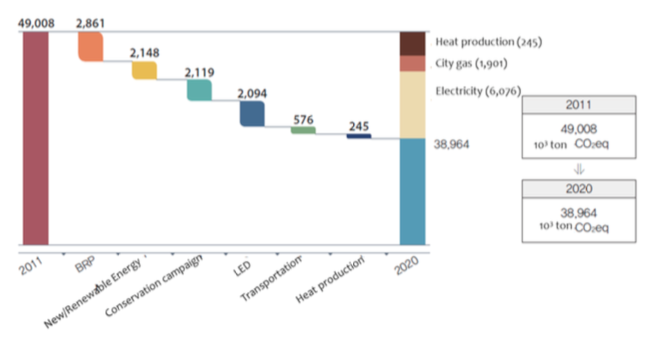
As the city of Seoul declared the leadership in ‘initiative of local government for sustainable development’ at the 1st International Forum on Urban Policy for the Sustainable Development Goals in 2016, it is very important for the city to secure technical and political fundamentals to achieve the SDGs effectively. New and renewable energy production from WWTP has significant meaning for Seoul as well as from the level of country.
Goal of the Policy
When transforming the wastewater with high concentration of organics into energy and resources, theoretically about 10 time more energy can be extracted than required for treatment of the wastewater. Some WWTP’s in Germany and Denmark are producing more energy than required for treatment, i.e., energy self-sufficiency is over 100%.
The energy self-sufficiency of WWTP’s in Seoul is 51.3% as of 2016. The goal of the project 2020 is to produce new and renewable energy from WWTP’s more than 100% of energy needed for treatment by 2020 (Figure 8).

The energy self-sufficiency of WWTP’s in Seoul is 51.3% as of 2016. The goal of the project 2020 is to produce new and renewable energy from WWTP’s more than 100% of energy needed for treatment by 2020 (Figure 8).

Figure 8. Energy self-sufficiency goal for WWTP’s of Seoul
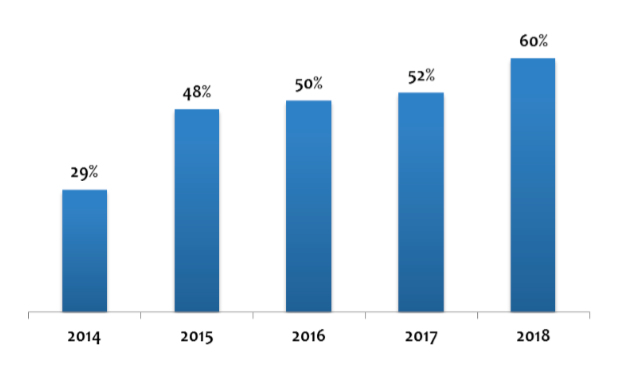
The city of Seoul has been preparing the comprehensive energy management plan for WWTP’s since May 2016. The energy oriented management plan will be completed in January 2017 for three different time frames, i.e., short, mid, and long-term plans.
The plan will include 1) goal for energy self-sufficiency of the WWTP, 2) sound foundation for energy oriented management of WWTP, 3) expansion of energy production and promotion of energy business, and 4) projects for energy conservation and efficiency improvement.
Main Contents of the Policy
Mast Plan for Energy Self-sufficiency of WWTP, MOE
The Ministry of Environment of the central government of Korea announced the ‘Master Plan for Energy Self-sufficiency of WWTP’ to save energy and produce new and renewable energy using green environmental technologies in 2010. According to the report for the plan, the electricity used in WWTP’s was about 0.5% of the total power used in Korea but the energy self-sufficiency of WWTP’s was only 0.8% (MOE, 2010). The plan had three step-wise goals; 18% of energy self-sufficiency in the 1st stage (2010~2015), 30% in the 2nd stage (2016~2020), and the 3rd stage (2012~2030) 50%.
The goals will be achieved through 1) energy conservation, 2) building fundamentals for energy self-sufficiency, 3) Utilization of unused energy, 4) production of natural energy (MOE, 2010).
Seoul has just completed the 1st phase of the energy project, ‘One Less Nuclear Power Plant’ (2012~2014). The goal of the 1st phase of the project was to reduce consumption of energy and produce new and renewable energy of 2 million TOE, which is the power generating capacity of a nuclear power plant. The city of Seoul has been carrying out the 2nd phase of the project, known as ‘Energy producing city’, to increase the energy self-sufficiency of Seoul to 20% in 2020 (SMG, 2014).

The goals will be achieved through 1) energy conservation, 2) building fundamentals for energy self-sufficiency, 3) Utilization of unused energy, 4) production of natural energy (MOE, 2010).
Seoul has just completed the 1st phase of the energy project, ‘One Less Nuclear Power Plant’ (2012~2014). The goal of the 1st phase of the project was to reduce consumption of energy and produce new and renewable energy of 2 million TOE, which is the power generating capacity of a nuclear power plant. The city of Seoul has been carrying out the 2nd phase of the project, known as ‘Energy producing city’, to increase the energy self-sufficiency of Seoul to 20% in 2020 (SMG, 2014).

Figure 9. Energy production in Seoul (SMG, 2014)

The largest part of energy production comes from the energy produced from the wasted heat such as wastewater heat and it takes 46% of all the energy produced and saved in Seoul (Table 2, Figure 9).
Table 2 Energy production in Seoul (SMG, 2014)
| Energy Producing Process | Energy Production |
Remark | |
| Power Generation | 57,403 | 22.1% | Photovoltaic, fuel cell |
| Wasted heat and geothermal heat | 119,218 | 45.9% | Wastewater heat, burning heat, geothermal heat |
| EIA | 82,912 | 31.9% | |
| Total | 259,533 | 10.0% | |
Energy Saving and Production in WWT and Sewerage Systems
As discussed above, the main approaches of the ‘Comprehensive Energy Management Plan for WWTPs’ can be categorized as follows; The first category is on building the foundation for energy self-sufficiency. The detailed projects for this approach are replacement and rehabilitation of the old facilities and renewable energy production from anaerobic fermentation of organic sludge. The second approach is capacity increase to save more energy and produce new and renewable energy. The projects to achieve the second category of the project are, energy saving by management of electric power demand, expanding utilization of biogas from digester, increasing capacity of sludge drying facilities, and active discovery of unused energy. The last category is about energy efficiency and process optimization. Streamlining process management of WWT system and energy saving from wastewater treatment processes are the projects for the third approach.
Technical Contents
The Water-Energy NEXUS in wastewater treatment systems, can be built from two approaches. One is energy saving by improvement of system efficiency and the other is producing new and renewable energy from WWT systems.
Considering the structural characteristics, the processes from which system efficiency can be expected include sewage collection, wastewater treatment, water reuse, and discharge of the treated wastewater.
568,000 kWh of energy is required to collect 1 m3 of wastewater in the US (Klein, 2005). The problem with wastewater collection through old pipe system is costs for old system improvement and decreased system efficiency by I/I (Inflow and Infiltration). Fortunately, the city of Seoul doesn’t need to use energy to transfer wastewater as wastewater is collected by gravitation in Seoul. But the city has to deal with increased treatment cost due to old pipe systems.
The improvement of system efficiency in wastewater treatment process has limit due to regulatory rigidity on water quality standards of the effluent and structural characteristics of financial operation and support for wastewater treatment system. For example, 13~29 billion US dollars of financial investment is required to improve the aged and deteriorated wastewater treatment system for the next two decades (CBO, 2002).
The process that uses most energy in wastewater treatment is aeration, which uses about 54.1% of the total energy used in whole wastewater treatment process in the US while the energy for pumping is 14.3% and digestion is 14.2%. In Seoul, wastewater treatment process takes 64% of the total energy used in a WWT, while 15% and 21% of energy is consumed for sludge treatment and common facilities, respectively (Choi, 2015).
Water reuse has advantage in energy savings not in wastewater treatment system itself but in transferring through pipe system as water does not need to be pumped from source to treatment process and distribution for use as water reuse is done at the point of use.
Only the new and renewable energy production among the whole Water-Energy NEXUS is discussed in the report as energy production is much larger than energy saving.
The city of Seoul has to treat 4.1 million m3 of wastewater every day as of 2014 and a part of biogas generated in the treatment process was burned out in the incinerator. The Nan Ji WWTP covering the northwestern part of Seoul has built and operated the 1st combined heat and power plant with the capacity of 3.1 MW using biogas since March 2013. Another biogas of 26,000 m3 is supplied every day to Korea District Heating Corporation. The corporation generates about 20,000 MWh of power every year and 24,000 GCal of heat supplied to 8,000 households. The Joong Rang WWTP covering the northeastern part of Seoul produces 6 million m3 of biogas every year and sells them as the city gas. 7.8 billion KW of the capital cost including the gas purification facilities was invested from the private sector.
Total energy used in the WWTPs in Seoul as of 2016 is 64,944 TOE (Table 3). Electricity takes 78% (50,781 TOE) of the total energy for the WWTPs.
Considering the structural characteristics, the processes from which system efficiency can be expected include sewage collection, wastewater treatment, water reuse, and discharge of the treated wastewater.
568,000 kWh of energy is required to collect 1 m3 of wastewater in the US (Klein, 2005). The problem with wastewater collection through old pipe system is costs for old system improvement and decreased system efficiency by I/I (Inflow and Infiltration). Fortunately, the city of Seoul doesn’t need to use energy to transfer wastewater as wastewater is collected by gravitation in Seoul. But the city has to deal with increased treatment cost due to old pipe systems.
The improvement of system efficiency in wastewater treatment process has limit due to regulatory rigidity on water quality standards of the effluent and structural characteristics of financial operation and support for wastewater treatment system. For example, 13~29 billion US dollars of financial investment is required to improve the aged and deteriorated wastewater treatment system for the next two decades (CBO, 2002).
The process that uses most energy in wastewater treatment is aeration, which uses about 54.1% of the total energy used in whole wastewater treatment process in the US while the energy for pumping is 14.3% and digestion is 14.2%. In Seoul, wastewater treatment process takes 64% of the total energy used in a WWT, while 15% and 21% of energy is consumed for sludge treatment and common facilities, respectively (Choi, 2015).
Water reuse has advantage in energy savings not in wastewater treatment system itself but in transferring through pipe system as water does not need to be pumped from source to treatment process and distribution for use as water reuse is done at the point of use.
Only the new and renewable energy production among the whole Water-Energy NEXUS is discussed in the report as energy production is much larger than energy saving.
The city of Seoul has to treat 4.1 million m3 of wastewater every day as of 2014 and a part of biogas generated in the treatment process was burned out in the incinerator. The Nan Ji WWTP covering the northwestern part of Seoul has built and operated the 1st combined heat and power plant with the capacity of 3.1 MW using biogas since March 2013. Another biogas of 26,000 m3 is supplied every day to Korea District Heating Corporation. The corporation generates about 20,000 MWh of power every year and 24,000 GCal of heat supplied to 8,000 households. The Joong Rang WWTP covering the northeastern part of Seoul produces 6 million m3 of biogas every year and sells them as the city gas. 7.8 billion KW of the capital cost including the gas purification facilities was invested from the private sector.
Total energy used in the WWTPs in Seoul as of 2016 is 64,944 TOE (Table 3). Electricity takes 78% (50,781 TOE) of the total energy for the WWTPs.
Table 3. Energy consumption in the WWTPs in Seoul by energy source
| Energy Source | Electricity | Heat recovery | Oil | LNG | Biogas | Total |
| Consumption | 50,781 78.2% |
5,391 8.3% |
41 0.1% |
22 0.03% |
8,709 13.4% |
64,944 |
The process which uses the largest portion of electric power energy is blower for aeration process. The energy for blower takes 49% (24,811 TOE) of the total energy used in WWTP (Figure 10).


Figure 10. Electric power consumption in WWTP of Seoul (Lee, 2016)

Considering the conditions discussed above, the ‘Comprehensive Energy Management Plan for WWTPs’ includes 1) building the foundation for energy self-sufficiency, 2) energy saving and new and renewable energy production, and 3) enhancing system efficiency and optimization.
Building the foundation for energy self-sufficiency
As blowers consume about 50% of electric energy of a WWTP, the city is carrying out projects to replace the aged and deteriorated facilities including blowers with new and efficient ones. In addition, sludge drying facilities are constructed to make the sludge into fuel. The energy produced from the dried sludge is estimated to be about 392 TOE.
Energy saving and new and renewable energy production
Electric power demand control project is carried out to reduce electric power consumption. As discussed before, the aged blowers will be replaced with new blowers with higher efficiency and energy saving functions. Power consumption during the peak season will be managed much more tightly.
The biogas from digester is the most tangible energy source among the new and renewable energies produced in a WWTP. The quality of biogas will be improved by tight maintenance of the desulfurizing facilities. The amount of biogas can be increased by adding chemicals to increase the yield. The capacity of the sludge dryer will be increased by 1,175 m3 by 2019 and the dried sludge will be sold as fuel for thermal power plants.
The city will actively search for unused energy such as small hydropower generation using hight difference of the effluent and heat supply to households in the area using wastewater heat 14.
Enhancing system efficiency and optimization
The operation of process in a WWTP will be optimized with advanced monitoring system. Energy consumption will be managed by plant and process to improve efficiency of treatment system. Optimization of the inflow pumps and efficient blower operation system corresponding to load fluctuation will be implemented to enhance system efficiency. In addition, highly efficient oil pressure motors for dehydrator and concentrator will be installed as one of the energy saving wastewater treatment processes.
The operation manual and incentive system to motivate energy saving is being prepared with replacement and improvement of processes and devices for higher system efficiency.
New and renewable energy production
The energy self-sufficiency goal for the project ‘Energy Producing City’, the 2nd phase of the project ‘One Less Nuclear Power Plant’, is 20% by 2020. The ongoing projects as of 2015 are as follows (Figure 11).
Project to use the biogas as fuel is a project to supply with the biogas from digestion process as the city gas. The annual energy saving estimated from the project is about 25,000 TOE from the 4 WWTPs in Seoul.
Photovoltaic power generation project is a project that makes use of the large space of WWTP to generate electric power using photovoltaic panels. Private sector as well as the city of Seoul invested together for the project. Photovoltaic power plants with total capacity of 5,545 kW are operated in the 4 WWTPs of Seoul and the annual energy saving from the project is estimated to be about 1,586 TOE.
Projects of combined heat and power plant based on biogas use biogas from digester, produce heat and power at the same time, and supply the customers with the heat and power. The heat from biogas combustion is supplied for digester heating first and the remaining gas is supplied to the heating company in the area. The electricity is sold to power trade market with higher price. The projects are based on private investment projects. The plant in the Nan ji WWTP has the capacity of 3.06 MW while that of the Seo Nam WWTP is 5.8 MW.
Projects on natural lighting for the underground utility tunnel use the sun light to light up the underground utility tunnel. The underground utility tunnel is improved into place with clean and pleasant conditions. Although the contribution of the project to energy saving is not big, the annual energy saving by the project is estimated to be about 20 TOE. The systems are installed and operated in the 245 utility tunnels in the Joong Rang WWTP and the Seo Nam WWTP.
Projects to recover heat from the effluent is a project to recover heat from the effluent using heat pump and use the energy for heating and cooling the offices and buildings in the WWTP. The Nan Ji WWTP and the Seo Nam WWTP use the energy for cooling and heating buildings and save about 12 TOE annually.
The most tangible project is the project to supply biogas as the city gas. The projects were also based on private investment. The wasted biogas is purified and supplied to the households as the city gas. The Joong Rang WWTP supplies with 26,000 m3 of gas every day. 5.3 million m3 of biogas is supplied to about 7,000 house holes every year through the project.

Figure 11. New and renewable energy producing facilities in WWTPs in Seoul

Heat supply to the area using wastewater heat is carried out with private investment. New projects for new and renewable energy in 2016 include small hydropower generation and heat supply to the area using wastewater heat. More than 200,000 Gcal of heat is generated annually in the Tan Chun WWTP and supplied to 20,000 households for heating. The heat recovered in the Seo Nam WWTP will be supplied to the community of Ma Gok with private investment. The community of Ma Gok will be supplied with 150,000 Gcal of heat annually (Figure 12).

Figure 12 Schematic illustration of heat supply to the district using wastewater heat
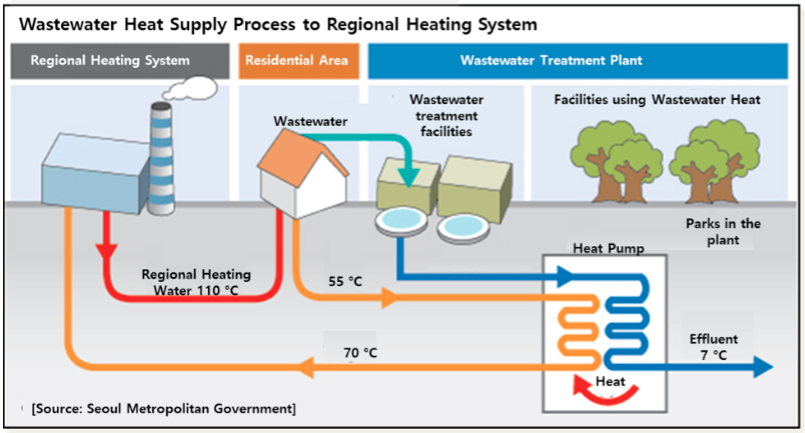
Projects of small hydropower plant using the effluent use the difference in height of the effluent for small hydropower generation. The Seo Nam WWTP started to operate the plant with the capacity of 100 kW in April 2015 while a plant with capacity of 60 kW has been built in the Joong Rang WWTP since November 2015. The wasted potential energy of the effluent can be used as a good source of new and renewable energy.

Figure 13. New and renewable energy production in the WWTPs in Seoul
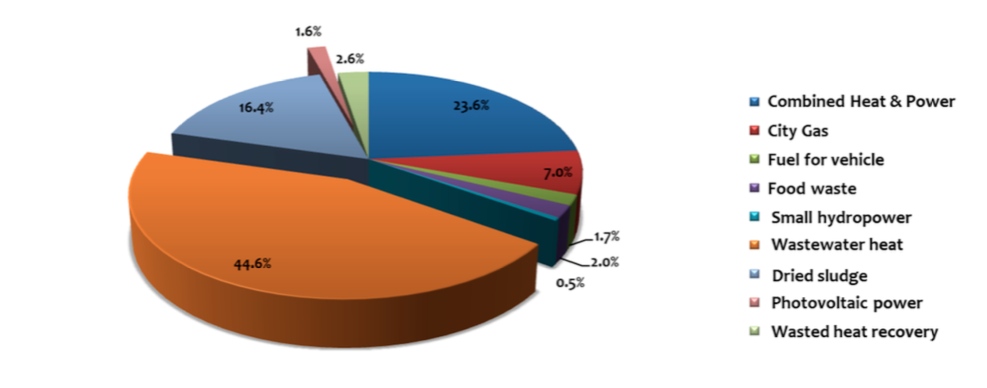
Effect of the Policy
Functional change of WWTP and improved energy self-sufficiency
The only function of WWTP in Seoul was treatment of wastewater. The modern WWTP is not a treatment plant any more but a power plant producing various types of energy as well as water resources from wastewater (Figure 14). The main function of WWTP is changing from treatment to energy generation and resources recovery.
The city of Seoul can achieve the goal of the 2nd phase project of ‘One Less Nuclear Power Plat’ successfully and contribute to UN’s SDGs achievement. Seoul can be evaluated to have technical and political foundations through energy self-sufficiency projects to move to low carbon economy.
Business model based on PPP(Public-Private Partnership)
Huge amount of budget is required to construct and maintain urban infrastructure including energy related facilities. The size of the structures in Seoul is the largest in Korea and the projects cannot be carried out only by public sector in terms of technical capability as well as financial capacity. The city of Seoul carried out the projects to produce and supply the new and renewable energy from WWTP based on multilateral cooperation business model for the city, private sector, and energy companies in the area to invest, construct and operate the systems together.
The project to supply heat to the area recovered from wastewater heat was taken as a successful project with business model based on the largest PPP in Korea. The similar business model was applied for the project of small hydropower generation, i.e., the WWTP provided with space for power generation facilities and carried out the administrative process while the private sector invested finance to design, construction, and operation of the facilities and would make earnings by sales of the energy produced from the facilities.
The project was also taken as a model of ‘new growth engine for green industry’, i.e. the local energy company could use the wastewater heat with lower price instead of supplying heat produced with higher priced LNG. The company could lower the unit price for supply, correspond to new heat demand, and secure reserve of heat (Choi, 2016).

Figure 14. Schematic illustration of new and renewable energy production in WWTP of Seoul (https://goo.gl/v5bxpe)
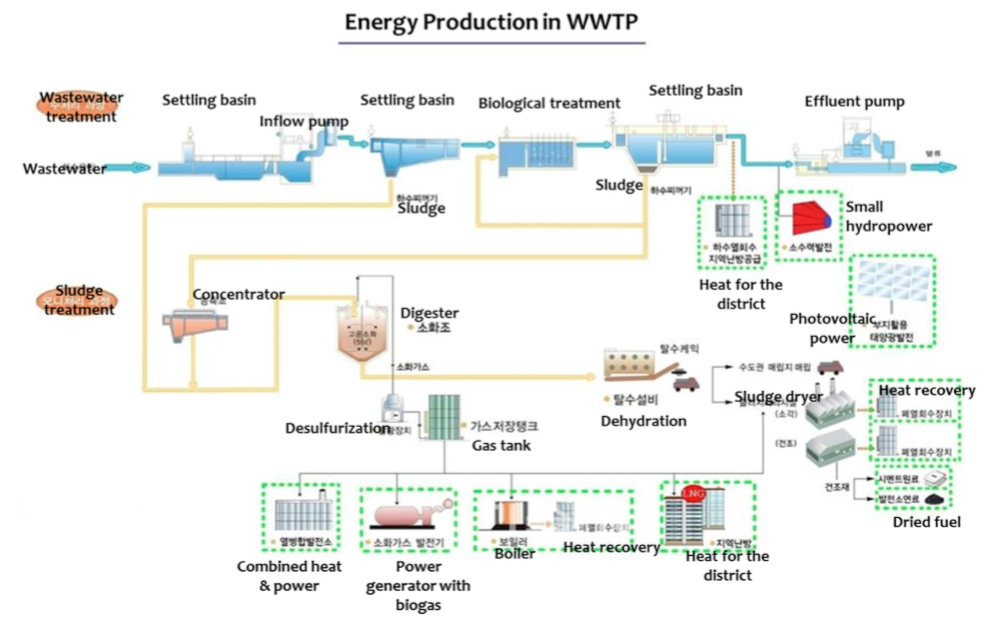
Overcoming technical adversities and expanding new technologies
For the project of small hydropower generation using head difference of the effluent to generate power, the effective head has to be larger than 2 m. The city of Seoul developed new technology, ‘power generating system with small head and flow’, to use small head effectively by using water flow and velocity.
(Baek, 2014). As the system can use water flow and velocity under small head condition, the technology can be applied to other WWTP with the similar conditions. Operated successfully, the project can be a new growth engine and contribute for job creation.
(Baek, 2014). As the system can use water flow and velocity under small head condition, the technology can be applied to other WWTP with the similar conditions. Operated successfully, the project can be a new growth engine and contribute for job creation.
Reduction of GHG and transformation to low carbon economy
Seoul already achieved energy self-sufficiency goal of 51.6% proposed by the ‘Master Plan for Energy Self-sufficiency of WWTP’ of the Ministry of Environment, 15 years prior to the target year. The total energy required for all the 4 WWTP’s in Seoul is similar to those needed for the 70,000 households in the Ha Nam city. The amount of energy saved and utilized from the processes of WWTP of Seoul including unused energy is the same as the energy consumed by the 37,000 households in the Sok Cho city. The financial effect can be calculated to be about 35.4 billion KW and the city could reduce about 3,5000 tons of CO2 emission with the project.
Difficulties and Overcome
The main adversities in producing new and renewable energy are financial and technical difficulties. As in the cases of other urban infrastructures, it takes huge amount of financial investment and high level of technical capacity for construction and operation of the facilities to recover resources and produce energy.
One of best way to overcome the difficulties is to adopt private investment and technologies based on the PPP (Public-Private Partnership) business model. For instance, the city provides with space for the business and the private sector constructs and operates the systems to generate electric power and sell the electricity to make profits.
The successful operation of the system for new and renewable energy generation and resource recovery in Seoul, can be a good model for public-private cooperation.
One of best way to overcome the difficulties is to adopt private investment and technologies based on the PPP (Public-Private Partnership) business model. For instance, the city provides with space for the business and the private sector constructs and operates the systems to generate electric power and sell the electricity to make profits.
The successful operation of the system for new and renewable energy generation and resource recovery in Seoul, can be a good model for public-private cooperation.
References
- Baek, Y.D., 2014, Small hydropower generation using effluent in WWTP, Daily Country, https://goo.gl/8nMNBS
- Bureau of Water Management, 2009a, Sewerage System of Seoul, Seoul Metropolitan Government
- Bureau of Water Management, 2009b, Master plan for Sewage System Maintenance 2020, Seoul Metropolitan Government
- CBO, 2002, Future Investment in Drinking Water and Wastewater Infrastructure, Congressional Budget Office
- Choi, I.S., 2016, WWTPs in Seoul changed into the outposts for new and renewable energy production, Khan, https://goo.gl/KS0dzK
- Choi, Y.J., 2015, Now and future of urban water reuse, SMG-Korean Society on Water Environment Joint Forum
- EPA, 2012, 2012 Guidelines for Water Reuse
- Headquarter for Climate and Environment, 2014, Seoul will be ‘Energy producing city’ following the success of the project, ‘One Less Nuclear Power Plant’, Seoul Archive (http://env.seoul.go.kr/archives/43330), SMG
- Hoppock, D.C., Webber, M.E., 2008, Energy needs and opportunities at POTWs in the United States, In Proceedings of the American Society of Mechanical Engineers (ASME) 2nd International Conference on Energy Sustainability, Jacksonville, FL, USA
- Kim, K.H., 2016, Adoption of the Paris Agreement and Our Strategies, Science and Technology Policy Institute (STEPI)
- Klein, G., Krebs, M., Hall, V., O’Brien, T., Blevins, B., 2005, California’s Water-Energy Relationship, California Energy Commission
- Kwok, D.H., 2007, Terminology of drinking water and wastewater system
- Le Blanc, D., 2012, Back to our common future: Sustainable Development in the 21st century (SD21) project, UN DESA
- Lee, C.H., 2016, Energy self-sufficiency of WWTP in Seoul, Proceeding of the seminar on the New Technologies for Wastewater Treatment and Energy, Seoul Water Institute.
- Lee, Y.J., 2015, Governance and stakeholder participation: Key to policy making – Regional and urban case studies from Germany and Korea, Seoul International Energy Conference 2015
- Means, E.G., 2004, Water and wastewater industry energy efficiency: A research roadmap, Water Research Foundation, Denver, CO, USA
- MOE, 2010, Master Plan for Energy Self-sufficiency, Department of Wastewater, Ministry of Environment (MOE)
- NREL (National Renewable Energy Laboratory), 2012, Renewable Electricity Futures Study: Exploration of High-Penetration Renewable Electricity Futures, vol.1
- Seoul Development Institute, 2010, Seoul Research Database – Sewerage system
- Shin, H.S., 2016, German cities competing for the future, Shi Sa IN (November 10, 2016; http://www.sisain.co.kr/?mod=news&act=articleView&idxno=27460)
- SMG, 2014, One Less Nuclear Power Plant Project, the message of hope for the energy policy of Seoul, Seoul Metropolitan Government (SMG), OLNPP Citizens’ Action Committee
- Stillwell, A.S., Hoppock, D.C., Webber, M.E., 2010, Energy recovery from wastewater treatment plants in the United State: A case study of the Energy-Water Nexus, Sustainability 2, 945 – 962
- UNFCCC, 2016, The Paris Agreement, http://unfccc.int/paris_agreement/items/9485.php (last surfed on Dec. 15, 2016)
- US GAO (Government Accountability Office), 2012, Energy-Water NEXUS. Coordinated federal approach needed to better manage energy and water tradeoffs, GAO-12-880
- Won, D.K., 2016, Main contents of the Paris Agreement and issues related with power industry, KEMRI REVIEW
- Yu, J.R., et al., 2015, One Less Nuclear Power Plant 2: Energy Producing City, Seoul, Seoul Metropolitan Government
